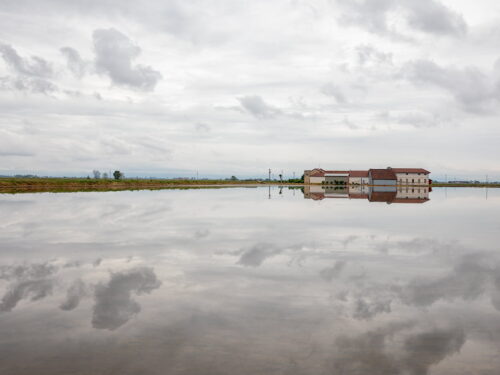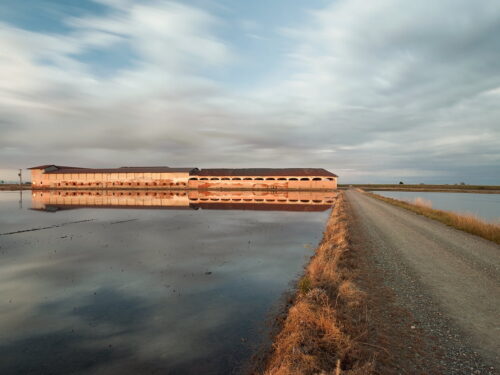SULLE STRADE DEL RISO.
Girovagando nei mesi primaverili, sulle strade e sui sentieri di campagna tra Vercelli e Novara, ho potuto apprezzare il paesaggio della pianura padana che assume caratteristiche speciali ed uniche. La campagna, divisa in vasche delimitate da piccoli argini di terra alti 30–40 cm, viene allagata con l’ acqua convogliata da canalini e ruscelli e regolata da un sistema di chiuse. E’ il lavoro preliminare alla semina del riso. Ed il paesaggio, nelle giornate senza vento, è fatto di specchi d’acqua immobili nei quali si riflettono i filari di pioppi e le cascine; i riflessi, più avanti, agli inizi di giugno, quasi spariscono e le grandi vasche d’acqua si trasformano in bacini pieni di pianticelle di un verde intensissimo, la quintessenza del verde. I casolari che qui e là costellano la pianura, sono spesso di enormi dimensioni e sono accompagnati da quelle che erano le abitazioni delle lavoratrici e dei lavoratori del riso e da chiese o cappellette, assumendo l’aspetto di veri e propri borghi. Essi tuttora vivono come aziende agricole ma sono anche lì come vestigia e testimonianze di un’epoca passata, quando per la semina, i ritrapianti e la monda, occorrevano migliaia di lavoratori stagionali, soprattutto donne (mondine), che in queste cascine vivevano per alcuni mesi dell’anno, da marzo a luglio. Questo lavoro ha sempre colpito l’immaginario popolare e ha ispirato molti canti popolari, oltre che opere letterarie e cinematografiche e, da ultimo, un magnifico libro fotografico di Gianni Berengo Gardin: Il Racconto del Riso. Da quando mi dedico alla fotografia di paesaggio, quasi ogni anno faccio un giro per risaie cercando cascine in mezzo alla risaie da fotografare,tra acquazzoni, temporali, vento, fulmini, arcobaleni o con atmosfere immobili. Il risultato fotografico di questo girovagare per risaie è riassunto nella selezioni di immagini che si possono vedere qui sotto.
ON THE RICE ROADS
Wandering in the spring time on the roads and country pathways, between Vercelli and Novara in northern Italy, I appreciated the landscape taking special and unique features. The campaign, divided into tanks bounded by small embankments of 30-40 cm high ground, is flooded with the water, conveyed by small channels and streams and regulated by a system of locks. It is the preliminary work for the rice planting. The landscape, in the windless days, is made by motionless water mirrors in which are reflected the rows of poplars and farms; reflections, later, at the beginning of June, almost disappear and the large water pools are transformed into basins full of rice seedlings of a deep green, the quintessence of the green. The farmsteads, here and there doting the plains, are often of enormous size and are accompanied by former houses of rice workers and by churches or chapels, assuming the appearance of small villages. They still survive as farms but they also represents the traces and proofs of a bygone era, when thousands of seasonal workers, especially women (pickers), were involved in the sowing, the transplanting and the cleaning of rice; they lived in those farms for some months of the year, from March to June. This work has always moved the popular imagination and inspired many folk songs, as well as literary and cinematographic works and, most recently, a magnificent book of photographs by Gianni Berengo Gardin: The Story of Rice.
Since I’m dedicated to landscape photography, almost every year I make a tour into the rice fields, looking farmhouses in the rice fields for photographing them, between showers, thunderstorms, wind, lightning and rainbows to with quite atmospheric conditions. The photographic result of this wandering, through rice fields, is summarized in the selection of images which can be seen below.




























